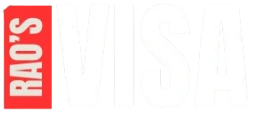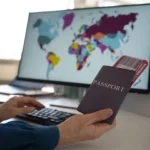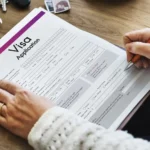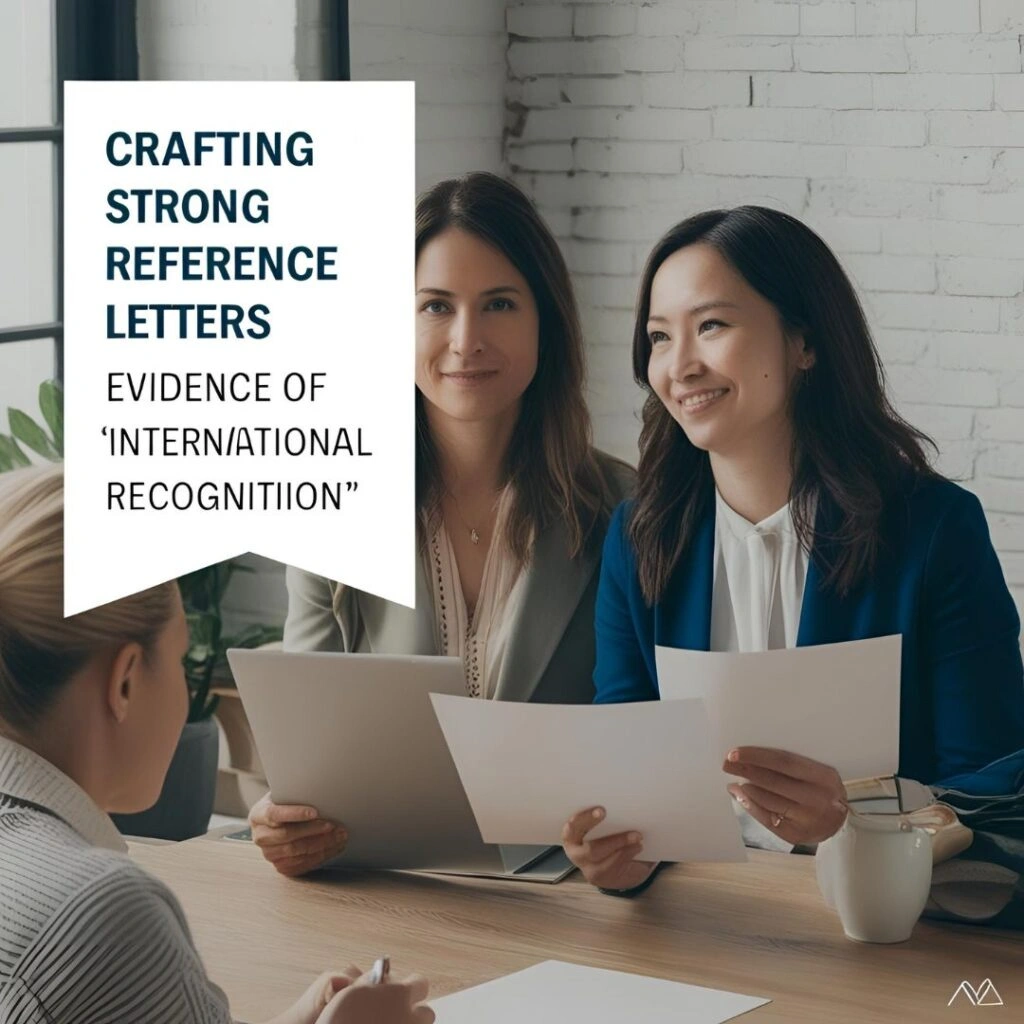Reference Letters: Essential Elements
In order to prove “international recognition” in EB-1B cases, reference letters are essential supporting documentation. Letters that are effective should contain:
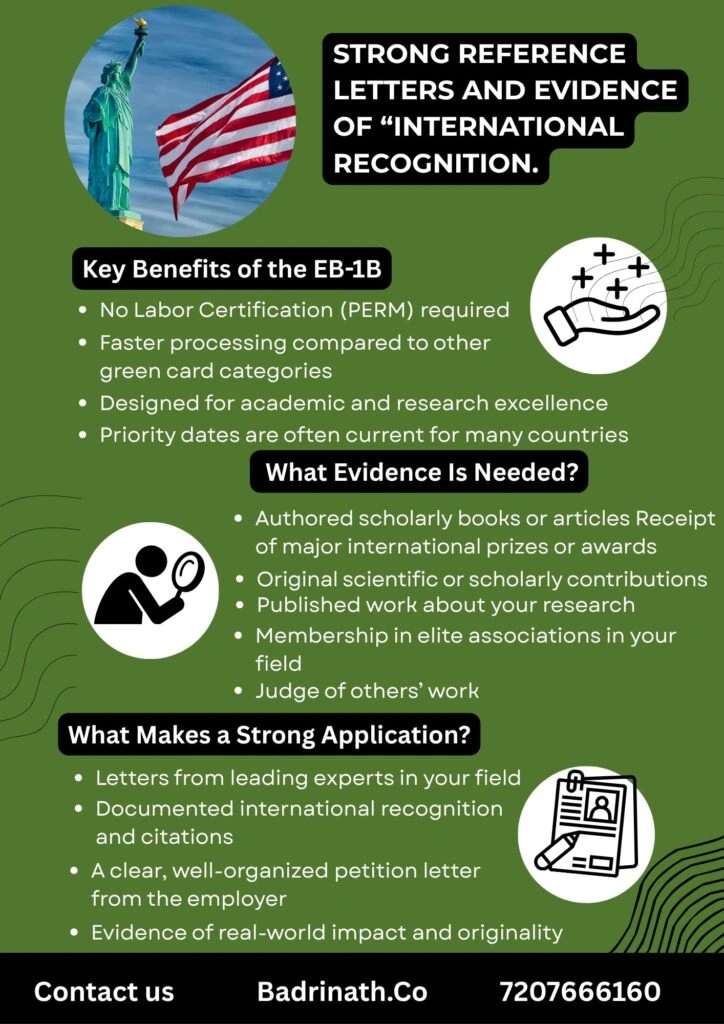
1. Suitable Writers
- Independent Experts: Letters from reputable people who haven’t dealt with you directly typically hold a lot of weight.
- Geographic Diversity: To show genuinely global recognition, include letters from experts in other nations.
- Institutional Diversity: Get recommendation letters from experts at prestigious universities, research facilities, and relevant trade associations.
2. Content Structure
- Clear Identification: Author should establish their own credentials and position in the field
- Relationship Statement: Explain how the author knows your work (through publications, conferences, collaborations)
- Particular achievements: Give specific examples to support your unique scholarly or scientific achievements.
- Impact Analysis: Explain how your work has influenced the field, including specific examples of others building upon your research
- Comparative Language: Position you among the top percentage of researchers in your field
3. Evidence of Major Significance
The letters should explicitly address how your contributions are:
- Also original and innovative
- Widely adopted or cited
- Influential in changing practices or understanding in the field
- Recognized through invitations to present at major conferences
Additional Evidence of International Recognition
Beyond reference letters, strengthen your case with:
1. Publication Record
- Peer-reviewed Articles: Emphasize publications in high-impact, internationally-recognized journals
- Citation Analysis: Provide evidence of citations to your work, especially by researchers from different countries
- Journal Impact Factors: Indicate how well-known the journals you have published in are.
2. Conference Presentations
- Peer-reviewed Presentations: Document presentations at major international symposia.
- Invited Talks: Highlight instances where you were specifically invited to present your research
- Conference Selectivity: Provide acceptance rates for particularly competitive conferences.
3. Judging Others’ Work
- Journal Reviewer: Evidence of serving as a reviewer for peer-reviewed scholarly journals
- Conference Committee: Documentation of roles on program committees for international conferences
- Grant Reviewer: Confirming invitations to review grant applications
4. Awards and Recognition
- Research Prizes: Proof of winning significant honors or prizes for exceptional performance.
- Fellowship Status: Documentation of competitive research fellowships or grants
- Professional Association Recognition: Recognition from professional societies in your field
5. Citation Indices
- Citation Index Entries: Multiple entries in citation indices showing your work cited as authoritative.
- H-index or Comparable Measures: Quantifiable proof of the significance of your study
- Comparative Analysis: How your citation metrics stack up against those of people in comparable stages of their careers
Organizational Strategy
When preparing your EB-1B petition:
- Sort Evidence: Clearly arrange the documents to meet at least two of the six requirements.
- Create a Compelling Narrative: Develop a cohesive story about your international recognition
- Quality Over Quantity: Don’t list all of your contributions; instead, concentrate on your most important ones.
- Chronological Progression: Illustrate how your work has changed and grown in influence.
- Consistent Terminology: Use consistent language across all documents
Remember that USCIS uses a two-part analysis for EB-1B cases, first determining if the evidence meets at least two criteria, and then making a “final merits determination” about whether you’re truly internationally recognized

Supporting Documentation to Strengthen Reference Letters
In addition to reference letters, provide direct evidence of accomplishments. Examples include:
- Google Scholar profile or citation reports
- Copies of high-impact publications
- Invitations or programs listing you as a speaker
- Proof of funded international research grants
- Membership in prestigious international associations
Ideal Reference Letters Mix
Aim for 5–7 high-quality letters, including:
- At least 2–3 from independent experts
- A mix of U.S.-based and international recommenders
- Letters from editors, department chairs, or industry leaders whenever possible
Final Thoughts: Letters that Build the Case
Finally, in high-skilled visa petitions like EB-1A, EB-1B, and EB-2 NIW, USCIS adjudicators rely heavily on written expert opinions. Moreover crafting persuasive, authentic, and evidence-backed reference letters is essential. Combined with a solid portfolio of published research, conference participation, and global recognition, these letters can make your petition stand out.
When done right, your letters don’t just praise your work — they validate your role as a global leader in your field.
SEO Keywords
- EB-1A reference letter tips
- Reference Letters
- International recognition EB-1B
- EB-2 NIW recommendation letter format
- USCIS reference letter examples
- How to prove international acclaim for green card
- Expert opinion letter immigration
- EB-1A strong letters of support
- STEM researcher green card recommendation
- Academic reference letter USCIS
- International recognition evidence for EB-1
Read More About the Topic
External Links
EB-1B: Green Cards for Professors and Researchers
EB-1B (Outstanding Researchers or Professors)
Internal Links
Employer Sponsorship and Job Offer Requirements Under EB-1B
EB-1B Eligibility for Postdocs, Assistant Professors, and Senior Researchers
